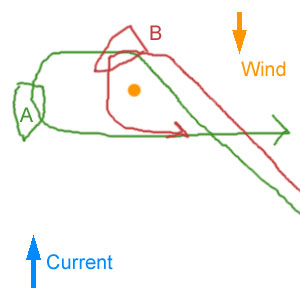











Boats for sale
| Rossiter Pintail Mortagne sur Gironde, near Bordeaux |
 |
| Laser 28 - Excellent example of this great design Hamble le rice |
 |
List classes of boat for sale |
taking a windward mark too wide |
Post Reply 
|
Page 123> |
| Author | |
x1testpilot 
Posting king 
Joined: 11 Feb 11 Location: Ealing Online Status: Offline Posts: 175 |
 Post Options Post Options
 Quote Quote  Reply Reply
 Topic: taking a windward mark too wide Topic: taking a windward mark too widePosted: 20 Jul 11 at 5:35pm |
|
Say 2 boats on starboard approach a windward mark to be taken to port A is clear ahead, but passes the mark and opens up a gap does there become a point where B could ever be allowed to slip inside A or does B have to wait till A has rounded however far A goes (till outside the zone?)? Or is B's only option to protest A for not hold rounding efficiently (proper course)?
In such situation if, having passed the mark, A gybes hard over before leaving the zone (a reasonable action without B being there) onto port, A would still maintain right of way till outside the zone? |
|
 |
|
Brass 
Really should get out more 
Joined: 24 Mar 08 Location: Australia Online Status: Offline Posts: 1151 |
 Post Options Post Options
 Quote Quote  Reply Reply
 Posted: 20 Jul 11 at 10:41pm Posted: 20 Jul 11 at 10:41pm |
|
Yes, B can go inside 'room given - room taken'.
CASE 63
At a mark, when room is made available to a boat that is not entitled to it, she may, at her own risk, take advantage of the room.
Two useful new appeals from the USA
Appeal 106 puts it rather neatly
[Once a boat has] left the mark astern and, [is] beyond the mark, not "at" it ... she therefore [is] no longer entitled to room to sail her proper course or to the exoneration provided by rule 18.5. ... Although rule 18.2(b) still applied, it had no effect because it did not specify any rights or obligations after [the boat] was no longer "at the mark."
A breaks no rule: A is not obliged to sail her proper course: sailing her proper course at the mark is a condition to A getting exoneration if she breaks a right of way or room to keep clear rule under rule 18.5, nothing more.
If A gybes onto port while B remains on starboard:
Edited by Brass - 21 Jul 11 at 12:28am |
|
 |
|
Andymac 
Really should get out more 
Joined: 04 Apr 07 Location: Derbyshire Online Status: Offline Posts: 852 |
 Post Options Post Options
 Quote Quote  Reply Reply
 Posted: 20 Jul 11 at 11:15pm Posted: 20 Jul 11 at 11:15pm |
|
Ah, good question.
The way I would interpret it; A is entitled to room to sail to the mark and room to sail its proper course whilst at the mark. The $64,000 question for me would be; was that a Proper course? If its course couldn't be justified (in the absense of the other boat) then I would say the right to mark room would be lost as soon as it had first passed the mark. Though I can't see how B can protest A for sailing 'above' its proper course. |
|
 |
|
Brass 
Really should get out more 
Joined: 24 Mar 08 Location: Australia Online Status: Offline Posts: 1151 |
 Post Options Post Options
 Quote Quote  Reply Reply
 Posted: 21 Jul 11 at 12:35am Posted: 21 Jul 11 at 12:35am |
|
Previous answer tarted up to make it clearer.
OP's scenario was that it would have been reasonable for A to gybe in the absence of B, so A is sailing her proper course.
The $64k question(s) are:
If A was not 'at the mark' 'proper course' is wholly irrelevant. B cannot protest A for sailing above her proper course, that's a rule 17 protest and rule 17 does not apply here. All B can do is protest A for failing to keep clear or failing to give B room to keep clear, and B's success in that protest will depend on whether A is entitled to exoneration under rule 18.5.
|
|
 |
|
x1testpilot 
Posting king 
Joined: 11 Feb 11 Location: Ealing Online Status: Offline Posts: 175 |
 Post Options Post Options
 Quote Quote  Reply Reply
 Posted: 21 Jul 11 at 10:42am Posted: 21 Jul 11 at 10:42am |
|
This is the rough scenario I was thinking of. All in the zone. Additional complication of a significant current means that B is catching up as B approaches the mark and so is easily able to slip inside A that has gone rather wide. A would want to gybe and luff onto port where she does, though that would mean B cannot avoid T-boning A.

|
|
 |
|
JimC 
Really should get out more 

Joined: 17 May 04 Location: United Kingdom Online Status: Offline Posts: 6661 |
 Post Options Post Options
 Quote Quote  Reply Reply
 Posted: 21 Jul 11 at 11:28am Posted: 21 Jul 11 at 11:28am |
|
In that circumstance I would say that B is taking a big risk. If they impede A in any way they are toast. If the current were running from right to left and there's a log jam at the mark you can often sneak through like that, but with the current in that direction its a bit more risky.
I have a happy memory of doing that at the Weston Grand Slam some years ago, and an aggrieved B14 shouting at us that we couldn't go through there because we had no rights. So we said, yes, agreed we have no rights at all, but if we don't get in your way we're OK:-) Edited by JimC - 21 Jul 11 at 11:31am |
|
 |
|
Rupert 
Really should get out more 
Joined: 11 Aug 04 Location: Whitefriars sc Online Status: Offline Posts: 8956 |
 Post Options Post Options
 Quote Quote  Reply Reply
 Posted: 21 Jul 11 at 11:49am Posted: 21 Jul 11 at 11:49am |
|
I'd agree - B can go in there, but take her lumps if things go wrong.
|
|
|
Firefly 2324, Puffin 229, Minisail 3446 Mirror 70686
|
|
 |
|
laser193713 
Really should get out more 
Joined: 13 May 09 Location: United Kingdom Online Status: Offline Posts: 889 |
 Post Options Post Options
 Quote Quote  Reply Reply
 Posted: 21 Jul 11 at 12:14pm Posted: 21 Jul 11 at 12:14pm |
|
I have always understood it that once A is past the mark, no longer overlapped with it, they lose all protection from rule 18 and then B becomes ROW boat in that situation. At the end of the day it is A that has gybed onto port while B may still have been on starboard so A is in the wrong then. If A luffs B hard then B has to avoid the mark which is an obstruction so A must give B room to do so as she is now reapproaching the mark.
I always think it is easier to picture mark rules when the boats are large yachts rather than dinghies. It is so easy in dinghies to get off a mark when hooked but imagine the consequences for a yacht doing this and getting forced onto a mark, particularly a metal racing mark. If A was to steer a course as shown they could be penalised for deliberately causing a collision if there was one because of the massive angle they have steered through in such a short space of time. |
|
 |
|
Brass 
Really should get out more 
Joined: 24 Mar 08 Location: Australia Online Status: Offline Posts: 1151 |
 Post Options Post Options
 Quote Quote  Reply Reply
 Posted: 21 Jul 11 at 2:56pm Posted: 21 Jul 11 at 2:56pm |
Yes, once A is past the mark and no longer 'at the mark' she ceases to meet the condition prescribed in rule 18.5 for her to be entitled to exoneration for breaking a part 2 rule. Rule 18,2(b), however, continues to apply, while ever Boat A remains in the zone (rule 18.2(c)), and if A once again sails 'to the mark' or becomes 'at the mark', Boat B must, again, give A mark-room. A, having gybed onto Port is not in the wrong unless she fails to keep clear of B and somehow or other is not sailing 'to the mark' or 'at the mark'. In all probability, if A is 'reapproaching the mark' she is sailing 'to the mark' and entitled to mark-room to do so. Once A is 'at the mark', provided her proper course is to luff, she may luff as hard as she likes, because rule 18.5 expressly gives her exoneration for breaking rule 16. A is absolutely entitled to 'slam the door' on B. Why do you say the mark is an obstruction? OP provided no evidence to suggest that it was. It should not be assumed that every mark is an obstruction. Normally racing marks, even of they are of metal or other solid construction, will be so designed that they are small enough that a boat one of her hull lengths from the mark would not need to change course substantially to pass and thus they do not meet the definition of Obstruction in the rules. Usually only a large shipping buoy is big enough to be an Obstruction. Whether the mark is an obstruction or not is somewhat irrelevant, even if it was an obstruction, while ever at least one of Boats A or B is in the zone, rule 18 continues to apply (rule 18.1), and when rule 18 applies, rule 19 does not (rule 19.1), except where the mark is a continuing obstruction (rule 18.1(c)). If A is taking mark-room to which she is entitled at the mark, her only 'unexoneratable' obligation, for which she can be penalised, is to avoid contact with B causing damage or injury (rule 14(b)). If there was contact between A and B without damage at the point of contact but which forced B into contact with a mark which caused damage to B (whether the mark was an obstruction or not: say a fitting on the mark gouged B's topsides), then A would have broken rule 14 and, on valid protest, would be liable to a penalty. There is no rule against 'causing a collision'. I suggest that, when discussing the rules, it is best to try to use the language of the rules themselves. It prevents misunderstandings. I don't agree that it is best to visualise rules applying to 'large yachts': probably better to envisage small racing keelboats, 20 to 30 feet, or larger, heavier dinghies, as what the original rule developers had in mind, although the racing rules committees are ever mindful of small dinghies (and giant multi-hulls).
Edited by Brass - 21 Jul 11 at 3:19pm |
|
 |
|
Andymac 
Really should get out more 
Joined: 04 Apr 07 Location: Derbyshire Online Status: Offline Posts: 852 |
 Post Options Post Options
 Quote Quote  Reply Reply
 Posted: 21 Jul 11 at 6:37pm Posted: 21 Jul 11 at 6:37pm |
But then who's going to get within the 3 boat length zone at Cape Horn
|
|
 |
|
Post Reply 
|
Page 123> |
| Forum Jump | Forum Permissions  You cannot post new topics in this forum You cannot reply to topics in this forum You cannot delete your posts in this forum You cannot edit your posts in this forum You cannot create polls in this forum You cannot vote in polls in this forum |
Bulletin Board Software by Web Wiz Forums® version 9.665y
Copyright ©2001-2010 Web Wiz
Change your personal settings, or read our privacy policy
Copyright ©2001-2010 Web Wiz
Change your personal settings, or read our privacy policy











 Printable Version
Printable Version Delicious
Delicious Digg
Digg Facebook
Facebook Furl
Furl Google
Google MySpace
MySpace Newsvine
Newsvine reddit
reddit StumbleUpon
StumbleUpon Twitter
Twitter Windows Live
Windows Live Yahoo Bookmarks
Yahoo Bookmarks Topic Options
Topic Options